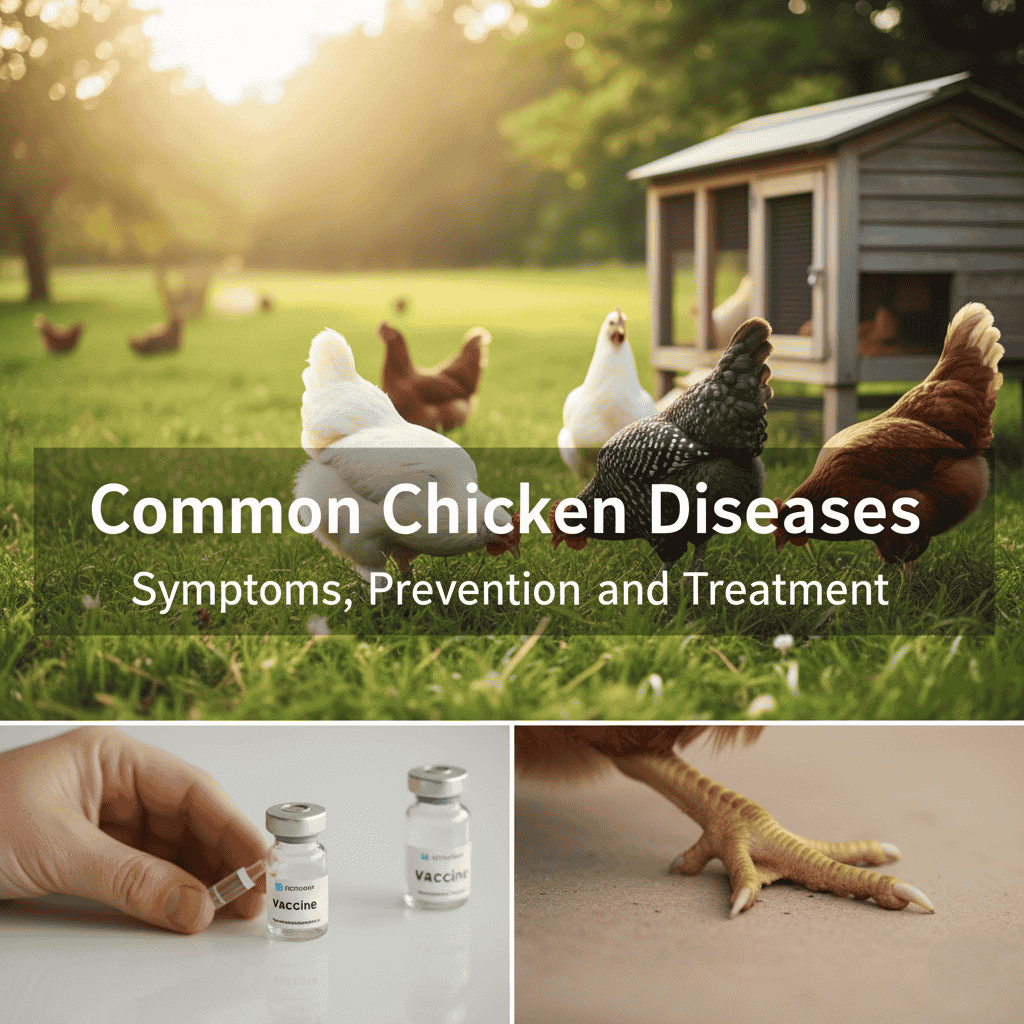Bringing a flock of chickens into your life is a joy, filled with the promise of fresh eggs and amusing companionship. However, a key part of responsible chicken keeping is knowing how to recognize and respond to illness. Chickens are masters at hiding their sickness, and a problem can quickly spread through a flock. Early detection is a chicken keeper’s most valuable skill.
This guide will help you understand the most common chicken diseases, their tell-tale signs, and what you can do to keep your flock healthy.
Recognizing the Signs of a Sick Chicken
Before you can identify a specific disease, you must be able to spot the general signs of a sick chicken. A healthy chicken is alert, active, and curious. Any deviation from its normal behavior is a red flag. Look for these key indicators:
- Changes in Behavior: A sick chicken will often become withdrawn, lethargic, and separate itself from the rest of the flock. It may huddle in a corner with ruffled feathers.
- Reduced Appetite and Water Intake: A decrease in the amount of food or water a chicken consumes is a strong sign of illness.
- Changes in Droppings: Diarrhea, watery droppings, or droppings with blood or an unusual color are all signs of a problem.
- Appearance: A sick chicken may have pale combs and wattles, a dull appearance, or a hunched posture.
Common Respiratory Diseases
Respiratory issues are a common and serious concern for chickens, as they can spread rapidly through the flock.
1. Mycoplasma
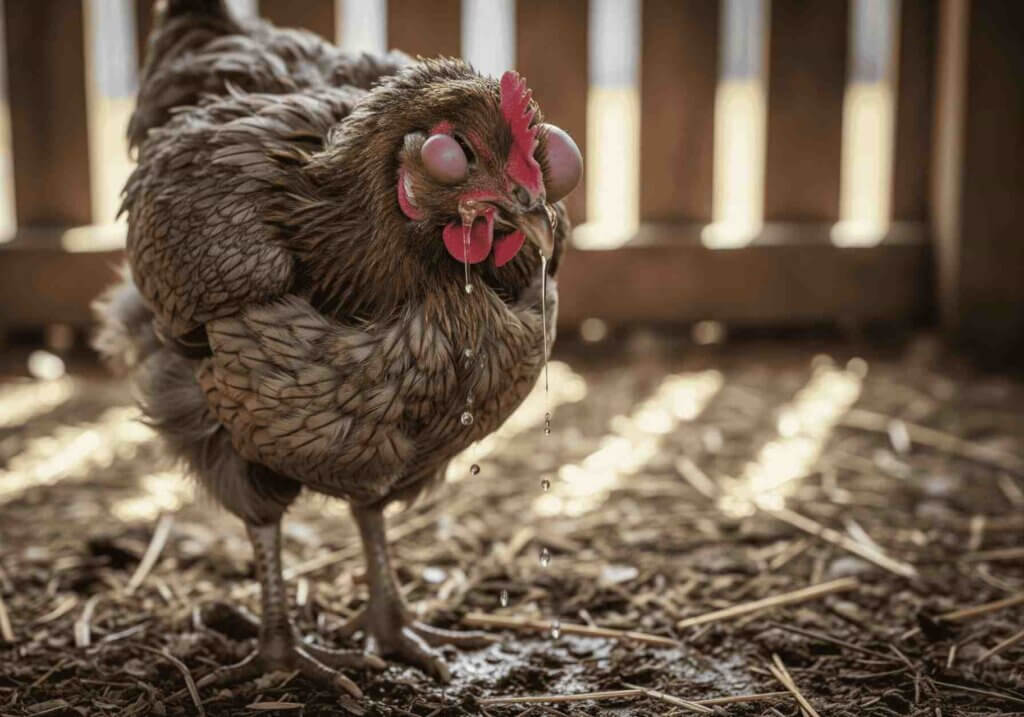
Mycoplasma, often called “chronic respiratory disease,” is a bacterial infection that is a frequent problem in backyard flocks.
- How it Spreads: Chickens can pass the bacteria to others, often without showing symptoms themselves.
- Symptoms: Look for a swollen face, runny nose, and sneezing. Chickens may also have a raspy breathing sound and a decrease in egg production.
- Prevention & Treatment: There is no permanent cure.. Antibiotics can help manage the symptoms during an outbreak, but strict biosecurity and culling of infected chickens are often necessary to eliminate it from a flock.
2. Infectious Coryza
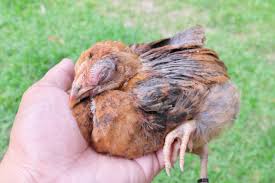
This is an acute, highly contagious bacterial infection of the upper respiratory tract.
- How it Spreads: It spreads through direct contact with infected chickens or contaminated water.
- Symptoms: The most prominent sign is severe swelling of the face, especially around the eyes and under the wattles. You may also notice a foul-smelling, thick nasal discharge.
- Prevention & Treatment: Antibiotics can be used to control an outbreak. Quarantine is essential, as the disease can be carried by asymptomatic chickens.
Parasites: Internal and External
Parasites are a problem for chickens and can cause a wide range of health issues if left unchecked.
1. External Parasites (Mites and Lice)
Mites and lice are tiny pests that live on a chicken’s body, causing irritation, feather damage, and anemia.
- How it Spreads: Mites and lice spread from bird to bird through direct contact or by living in the coop’s cracks and crevices.
- Symptoms: You may notice restlessness, excessive scratching, and feather loss. Look for scabs and dark, stained feathers around the vent. The Northern Fowl Mite lives on the bird, while the Red Chicken Mite hides in the coop during the day and feeds on chickens at night.
- Scaly Leg Mites: This specific type of mite burrows under the scales of a chicken’s legs, causing them to become thickened, crusty, and inflamed.
- Prevention & Treatment: Regular coop cleaning and dust baths can help. For scaly leg mites, applying a thick layer of petroleum jelly or vegetable oil to the legs can suffocate the mites and help the scales heal.
2. Internal Parasites (Coccidiosis)
Coccidiosis is one of the most significant protozoan diseases in poultry, especially for young chicks.
- How it Spreads: It’s caused by a parasite that is spread through contaminated feces.
- Symptoms: This disease can cause poor growth, ruffled feathers, bloody diarrhea, and weight loss.
- Prevention & Treatment: Many chick starter feeds are medicated to prevent coccidiosis. For older chickens, keeping a clean and dry coop is vital.
Viral and Bacterial Infections
These diseases are often more severe and require strict management to prevent a total flock loss.
1. Marek’s Disease
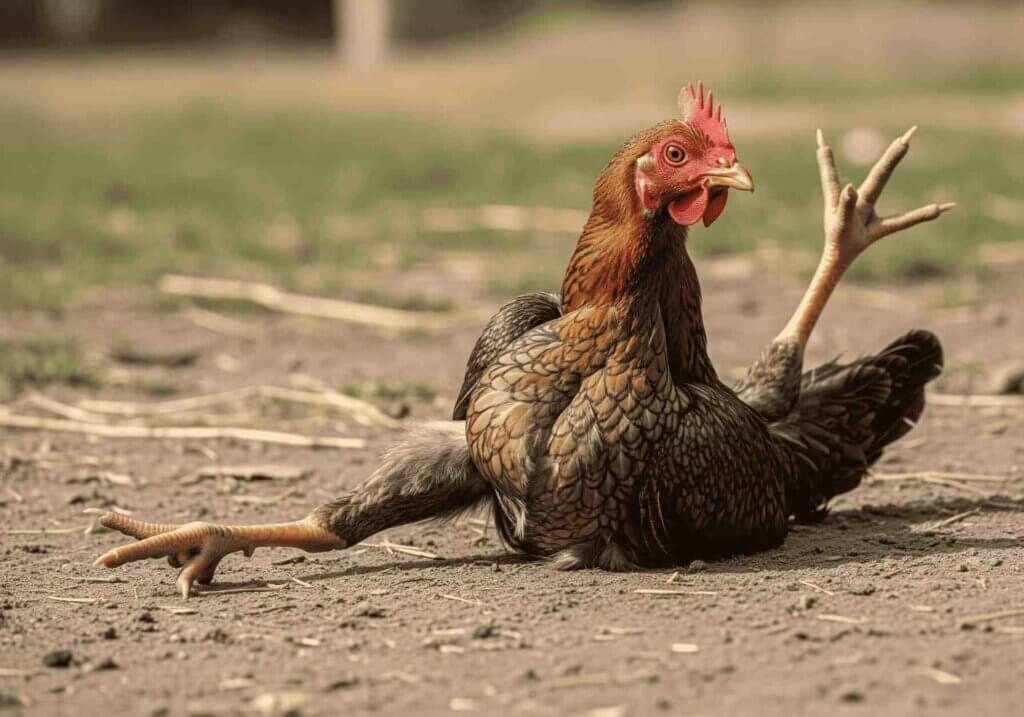
This is a highly contagious and feared viral disease of chickens that can cause tumors and paralysis.
- How it Spreads: The virus is spread through feather dander and dust in the environment.
- Symptoms: The most common form of Marek’s causes a progressive paralysis, where the chicken may hold one leg forward and one leg back. Other symptoms include tumors, weight loss, and blindness.
- Prevention & Treatment: There is no cure for Marek’s. The only effective prevention is vaccination, which is typically given to chicks at the hatchery.
2. Fowl Pox
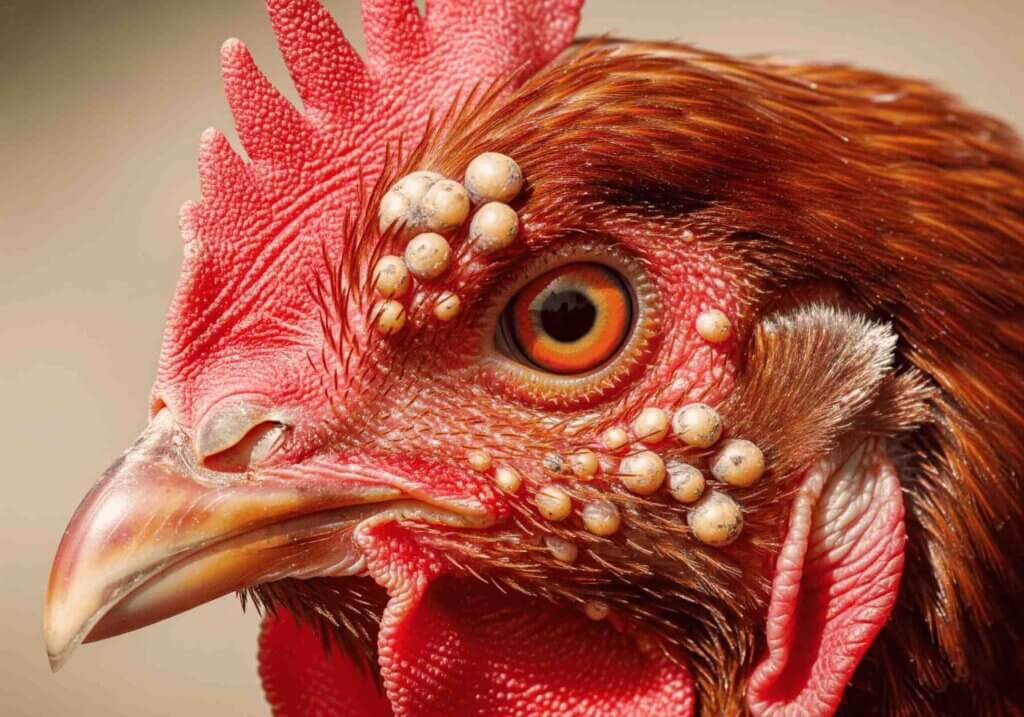
Fowl Pox is a viral disease that comes in two forms: a dry form that creates wart-like lesions on unfeathered skin, and a wet form that causes lesions inside the mouth and trachea.
- How it Spreads: The virus is transmitted through direct contact with infected chickens or by mosquitoes.
- Symptoms: The dry form causes scabby, wart-like growths on the comb, wattles, and face. The wet form can lead to difficulty breathing and eating.
- Prevention & Treatment: A vaccine is available for Fowlpox. The dry form usually resolves on its own within a few weeks, but supportive care is needed for the more serious wet form.
Other Common Issues
Beyond infectious diseases, chickens can suffer from a number of common ailments.
1. Bumblefoot
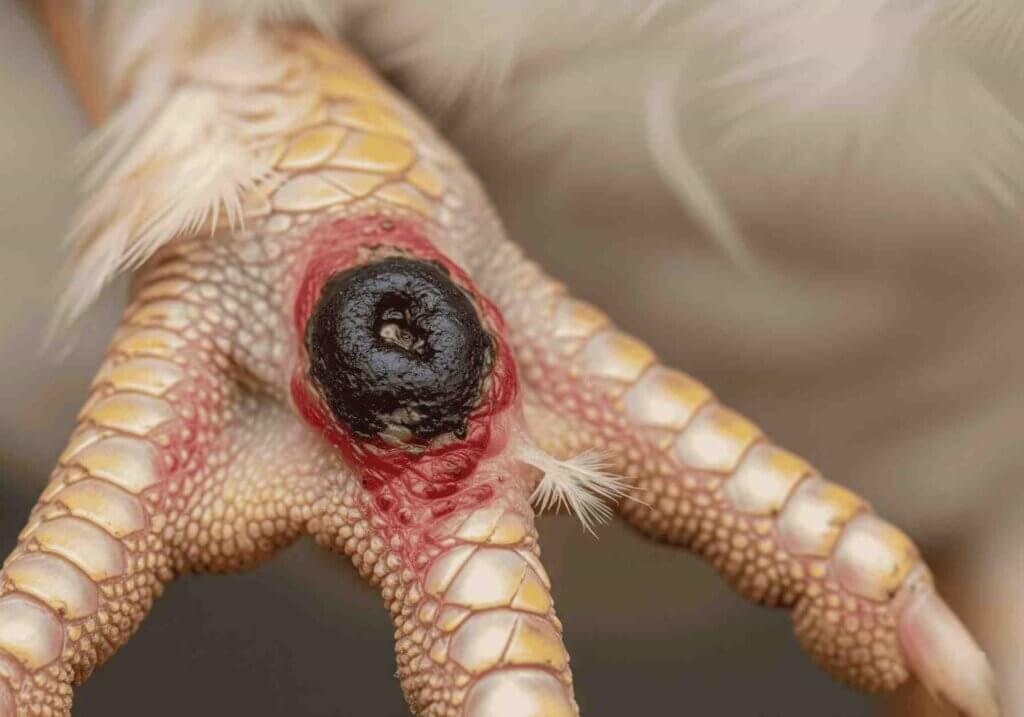
This is a bacterial infection of the footpad, often caused by a cut or scrape that gets infected.
- How it Develops: A small cut on the footpad allows bacteria to enter, leading to a swollen, painful abscess.
- Symptoms: A visible black or brown scab (the “kernel”) on the footpad, swelling, and lameness.
- Prevention & Treatment: Ensure your coop and run are free of sharp objects. Early cases can sometimes be treated with an antiseptic and a foot soak, but more severe cases require veterinary attention to remove the abscess.
2. Egg-Binding
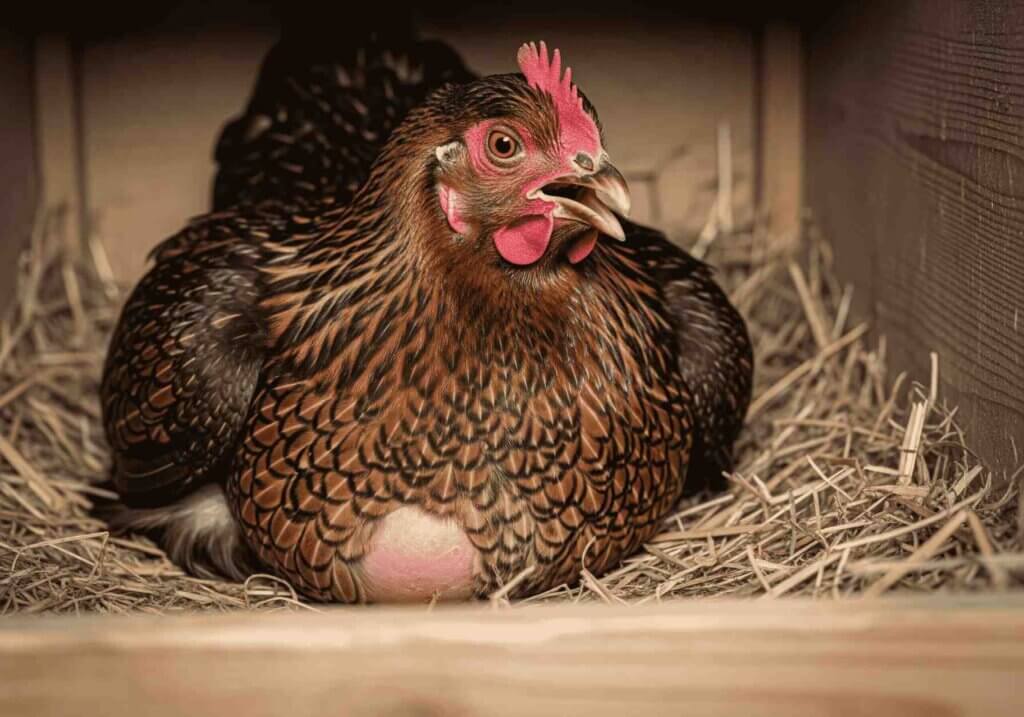
Egg-binding occurs when a hen is unable to pass an egg.
- How it Develops: This is often caused by a hen being too young to lay, a lack of calcium in the diet, or a very large egg.
- Symptoms: An egg-bound hen will appear distressed, lethargic, and may strain or squat repeatedly. You might feel a hard lump near her vent.
- Prevention & Treatment: A warm bath can sometimes help the hen relax and pass the egg. Providing a high-quality layer feed with adequate calcium is the best prevention. If the problem persists, contact a veterinarian immediately.
Frequently Asked Questions
Q: What are the first signs of a sick chicken?
Early signs of illness in a chicken often include a change in behavior, such as a decrease in appetite or water consumption, lethargy, and a tendency to isolate from the flock. Physical signs to look for are ruffled feathers, pale combs and wattles, and a change in the color or consistency of their droppings.
Q: How do you treat common chicken diseases naturally?
While many serious diseases require veterinary intervention or medication, some minor issues and parasitic problems can be managed naturally. For example, some natural remedies for mites and lice involve dust baths with diatomaceous earth. For scaly leg mites, applying a thick oil or Vaseline can suffocate the mites. Maintaining a clean coop and providing a healthy diet are the best forms of prevention.
Q: What is the most common disease in backyard chickens?
Some diseases are common in backyard chickens, but Coccidiosis is a frequently cited problem, particularly in young chicks. Mites and lice are also extremely common and can affect chickens of all ages.
Q: How can I prevent diseases in my flock?
Prevention is the best medicine. The most effective methods include practicing strong biosecurity, such as quarantining new chickens for at least 30 days. Keeping the coop clean and dry, providing a balanced diet with proper nutrition, and ensuring a stress-free environment are also crucial. For some diseases like Marek’s, vaccination is the only effective prevention method.
Hello! I’m Ibrahim, the owner and writer of this blog. I run a chicken farm with 160 chickens, and I’ve gained a lot of knowledge about raising and caring for them. Now, I want to share my insights and experiences with you to help you in chicken keeping.

